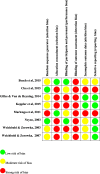Which interventions increase hearing protection behaviors during noisy recreational activities? A systematic review
- PMID: 32919462
- PMCID: PMC7488782
- DOI: 10.1186/s12889-020-09414-w
Which interventions increase hearing protection behaviors during noisy recreational activities? A systematic review
Abstract
Background: Hearing loss and tinnitus are global concerns that can be reduced through hearing protection behaviors (e.g., earplug use). Little is known about the effectiveness of interventions to increase hearing protection use in recreational domains. For the first time we review systematically the effectiveness of such interventions.
Methods: Systematic searches of nine databases, as well as grey literature and hand-searching, were conducted. Any study design was included if it assessed quantitatively a purposeful attempt to increase hearing protection in recreational settings. Studies were excluded if they assessed noise exposure from occupational sources and headphones/earphones, as these have been reviewed elsewhere. PROSPERO protocol: CRD42018098573.
Results: Eight studies were retrieved following the screening of 1908 articles. Two pretest-posttest studies detected a small to medium effect (d ≥ 0·3 ≤ 0·5), one a small effect (d ~ =0·2) and two no real effect. Three posttest experimental studies detected small to medium effects (d ≥ 0·3 ≤ 0·5). Studies were rated as "poor quality" and 17 out of a possible 93 behavior change techniques were coded, with the majority targeting the intervention function 'education'.
Conclusions: Hearing loss and tinnitus due to recreational noise exposure are major public health concerns yet very few studies have examined preventive interventions. The present systematic review sets the agenda for the future development and testing of evidence-based interventions designed to prevent future hearing loss and tinnitus caused by noise in recreational settings, by recommending systematic approaches to intervention design, and implementation of intervention functions beyond education, such as incentivization, enablement and modeling.
Keywords: Behavior change; Hearing conservation; Hearing protection behavior; Hearing protection intervention; Recreational noise activity; Recreational noise-induced hearing loss; Systematic review.
Conflict of interest statement
There are no conflicts of interest to report.
Figures
References
-
- World Health Organization . Hearing loss due to recreational exposure to loud sounds: a review. World Health Organization. 2015.
-
- Gopal K. Current practices in the assessment of recreational noise-induced hearing loss: a review: World Health Organization; 2017. https://www.who.int/pbd/deafness/Monograph_on_current_Practices_in_the_a.... Accessed November 2018.
Publication types
MeSH terms
Grants and funding
LinkOut - more resources
Full Text Sources
Medical



